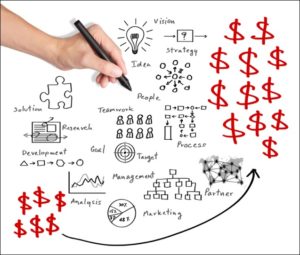
How to translate your business into a tool that enables you to make optimal decisions
What is the best way to build out a tool that enables a CEO to make informed decisions based on historical results and future projections? The process begins with an understanding of the company’s business model. It is essential to have a thorough understanding of what drives the business from product development to sales and marketing to delivery and customer service. How you make money is as important as what products or services you sell. What are you selling? To whom? How do you sell? Where do you sell? How do you price? How do you deliver? How many people do you need? The answers to these questions are needed to more accurately determine the future health of your business.
Business Model
The easiest place to begin is with an analysis of how the business generate revenues.
The What: As an example, you have a company that creates and sells software that automates billing for medical practices.
The Who: Your target market: who you sell your product to. Using the above example, based on the complexity of the system, your target could be all doctors’ offices throughout a specific geography that exceed $1 million in billings annually. If you add up the total potential revenues to be obtained if you could sell to every one of these offices, that would be called your “total addressable market.”
The How: The way in which you reach all these customers,; how you build an engaging website with screenshots, videos and testimonials from initial customers. You then create an e-mail marketing campaign and buy an e-mail list. You also hire an agency to manage your search engine marketing campaign via Google AdWords.
Revenue Model
To build the financial model for your business, you want to begin with your revenues. In the aforementioned example, revenues are typically comprised of various components: license fees (either one-time or monthly), support and maintenance fees, implementation and training, upgrades, add-on tools, training, and more. To create a forecast of your revenues you need to begin with an estimate of how many sales you will close, month-by-month, for the forecast period (typically the coming 12 to 24 months). Simplified, you can assume each sale is at the same price. Then, the number of sales multiplied by the license fee will give you the license revenues each month. You can then add in the amount of revenues to be realized from the implementation of the software and ongoing support fees. More advanced models will include variations for the size of the deal, lag times for implementation starts, pricing variability by type of deal, etc.
Cost of Revenues / Cost of Goods Sold
The next step is to estimate the cost of delivering the deals that you close. These costs are mainly the costs related to the people that are performing the services: business analysts, project managers, developers / engineers, trainers, and even the commissions that are paid to the sales executives. If you host the software, then the cost of hosting would be included as well. All these expenses are your Cost of Revenues (also known as Cost of Goods Sold). If you subtract Cost of Revenues from your Revenues then you will have the Gross Profit for your business.
Expenses
Expenses for your business are all the costs necessary to operate the business, excluding those costs for delivering the product(s) or services that you create which are included in Cost of Revenues/COGS. These operating expenses could include: General & Administrative (legal, professional fees, rent, telecommunications, technology, office expenses, etc.), Personnel, Sales & Marketing, Product Development/R&D and Other Expenses such as taxes, interest, depreciation, etc. When creating a budget, it is critical to take into consideration the revenues that you have assumed will occur. You need to ensure that you have enough people to deliver on the business that you are forecasting. Another item to consider are the sales and marketing expenses that will be required to generate the leads necessary for you to close the number of sales that have been assumed.
Tips
Following is a list of tips that will help you in creating a robust financial model:
- Lead with revenues, i.e. don’t load up on expenses until you are sure that the revenues will occur to cover all your expenses each month. You will need to invest in the business, either your own funds or outside capital, to create the product/service offering so you will have some up-front expenses. However, be prudent and don’t spend more than you can comfortably afford before revenues occur.
- Don’t overcomplicate the model. You need to have enough detail so that you can accurately forecast the business, but not so much detail as to create a model that is too difficult to maintain or revise. It’s a balance that you need to strike, but start simple and then layer in additional details over time as you become more comfortable with the model.
- Look at other models for examples of how to structure the revenue model, cost of goods sold, and operating expenses. By reviewing how other people have structured their financial models, you will learn valuable insights as to creating the proper design for your And, you may even find insights into improving your own business model.
When building a sound financial model, it may be helpful to first look at the business as a whole and understand exactly what you are trying to accomplish as well as what the intended use of the model and projections will be. Consistently ask yourself whether the numbers make sense, from the top, down and from the bottom up, so you can build a realistic range of outcomes for your business. This is an opportunity to be creative with your vision, the architecture of the model and ultimately your business. Design. Refine. Reflect. Implement.

